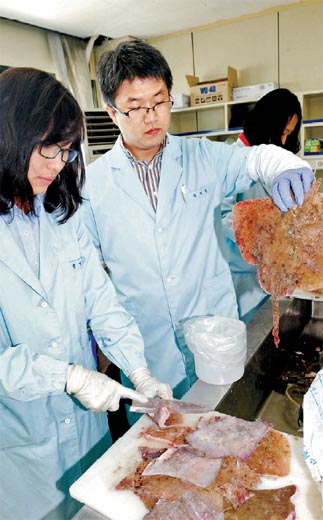Radioactive rain, wind expected for this week

Workers at Busan’s National Fisheries Products Quality Inspection Service screen samples of imported Japanese fish yesterday. [NEWSIS]
But it can’t stop the wind, and weather conditions tomorrow may bring radiation to Korea.
Yesterday, the Korea Food and Drug Administration (KFDA) announced it has banned all leafy produce grown in Chiba Prefecture in northeastern Japan.
“The produce that will be banned are leafy vegetables produced in the cities of Asahi, Katori and Tako,” said a KFDA press release. The vegetables will also include asparagus, parsley and green onions.
The import ban was effective starting April 4. The KFDA had already banned imports of all produce from Fukushima, Ibaraki, Tochigi and Gunma prefectures from March 25.
The KFDA also said yesterday that Korea has not imported any agriculture from Chiba since the March 11 9.0-magnitude earthquake and tsunami that led to the nuclear crisis. Screening is still being carried out on all Japanese food products exported to Korea.
On the weather front, rain has been forecast by the Korea Meteorological Administration (KMA) for tomorrow, and as a high-pressure system moves to the south of Japan, a southwesterly wind will blow in the direction of the Korean Peninsula. As the wind will blow air directly from Japan, there is a high chance that radiation will also be carried along. The Korea Institute of Nuclear Safety (KINS) is expecting the radiation to be minimal in the 20 to 60 millimeters (0.8 to 2.4 inches) of rain expected on Thursday. Rainwater in Korea was found to be contaminated with radioactive isotopes from the Fukushima power plant over the weekend.
Also yesterday, the Ministry for Food, Agriculture, Forestry and Fisheries announced that screenings detected no iodine or cesium isotopes in 58 types of agricultural and aquatic animals raised in Korea. The screenings were carried out on products from eight cities and provinces on the eastern border of Korea, closest to Japan, from March 29 to Monday.
Seven types of aquatic animals including mackerel, squid and crabs were already being screened on a weekly basis from March 14 by the National Fisheries Products Quality Inspection Service. The government plans to start screening cow milk from the eastern border of Korea and near the demilitarized zone starting this week, and it expects to expand screening to meat in the next few days.
Although the Japanese government announced recently that radiation-contaminated beef had been found near the Fukushima plant, Korea has not imported Japanese beef since 2001, when mad cow disease broke out in the country.
Government officials have also expressed concerns about Japan’s plan to dump 11,500 tons of water contaminated with low levels of radiation into the Pacific Ocean. The water was stored in tanks after it was used to cool down the troubled reactors at the Fukushima power plant. Koichiro Nakamura, a deputy director general of Japan’s Nuclear and Industrial Safety Agency (NISA), mentioned the plan to dump water during a press conference in Vienna on Monday. The dumping will be done to make more room to store water with higher radiation levels.
“If needed, we will ask the Japanese government for an on-site examination,” said Park Suk-hwan, the first vice minister of foreign affairs and trade, at the National Assembly yesterday. Park said that the Japanese government had not discussed with the Korean government its plan to dump radioactive water into the ocean.
By Christine Kim [christine.kim@joongang.co.kr]
한글 관련 기사 [중앙일보]
일 방사성 물질 남서풍 타고 온다
7일께 한반도로 유입 가능성
기상청 “전국에 20~60㎜ 비”
한반도에 내리는 빗물에서 일본 후쿠시마(福島) 원전에서 유출된 방사성 물질이 또다시 검출됐다. 한국원자력안전기술원(KINS)과 기상청은 3일 오전 10시 부산 등 7개 지역에서 채집한 빗물을 분석한 결과, 7개 지역 모두에서 방사성 요오드(I131)가 검출됐다고 4일 밝혔다. 요오드의 방사능은 L당 0.106~1.06Bq(베크렐)로 측정됐다.
KINS 윤철호 원장은 “빗물에서 가장 많은 방사성 물질이 검출된 청주의 경우 1.06Bq/L로 일반인의 연간피폭선량(검출된 농도의 빗물을 하루 2L씩 1년간 마셨을 경우의 피폭선량)으로 환산하면 X선 한 번 촬영 때 받는 방사선의 6분의 1 수준으로 인체에는 안전하다”고 말했다. 공기 중의 방사성 요오드는 전국 12개 측정소에서 ㎥당 0.121~0.636Bq 수준으로 검출됐다. 서울·대전·대구 등 7곳에서는 방사성 세슘도 함께 검출됐다. 농도는 인체에 무해한 수준이었다. 전국 23개 주요 정수장에서 공급한 수돗물에서는 아직 방사능이 검출되지 않았다.
기상청은 7일 고기압이 일본 남쪽으로 옮겨가면서 동일본 대지진 이후 처음으로 남서풍이 한반도 쪽으로 불어와 방사성 물질이 한반도로 유입될 가능성이 있다고 밝혔다. KINS 측은 그러나 방사성 물질의 양은 극미량일 것으로 예상했다. 7일 전국에는 20~60㎜의 다소 많은 비가 내릴 것으로 예보됐다.










with the Korea JoongAng Daily
To write comments, please log in to one of the accounts.
Standards Board Policy (0/250자)